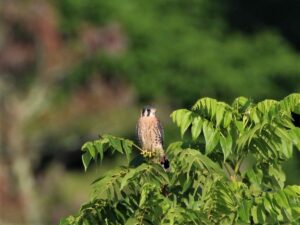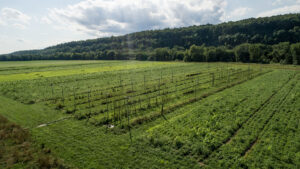A FARMER AND BIOLOGIST WORK TOGETHER TO CREATE NESTING HABITAT IN A HOP YARD FOR DECLINING AMERICAN KESTRELS
By Anne Bloomfield
Anne Bloomfield is the Applied Farmscape Ecology Program Manager
The dream felt so real. I watched the kestrel soar high in the sky over the hop yard, hovering from a fixed position as they do when looking for prey. Then, she circled back towards me, calling as she swooped in low and entered the nest box Jayne and I put in the hop yard the year before. When I awoke, reality hit. It was still winter. It was January and the kestrels would not be nesting until May. Many months have passed since then. Today is October 5th and as many of our summer breeding birds migrate south, I am reflecting on all we have observed and learned since then.
In 2018, farmer trainee Jayne Henson and I designed a kestrel habitat management study as part of her project growing hops at the Farm Hub. The idea was to explore the feasibility and effectiveness of having hop growers in our area put kestrel boxes on their hop poles for nesting. We wanted to more deeply explore potential opportunities for growers and ecologists to work together to manage agricultural lands with avian biodiversity in mind. With Jayne’s extensive knowledge of agriculture, my expertise in birds and our commitment to biodiversity we made a perfect team for the study.

The American Kestrel (Falco sparverius) is North America’s smallest falcon coming in at about 10 inches in length from bill to tail. They are also the most abundant. Despite this abundance, recent studies suggest that many kestrel populations are not only declining but alarmingly, kestrel body size is shrinking (Ely et al 2018) and their decline is particularly significant here in the Northeast. The exact reasons for their population decline are still under investigation. Biologists suspect it could be from factors such as reduced food availability, climate change and habitat loss. Kestrels use farmland habitat for feeding and nesting. Therefore, when farmland is developed in favor of urbanization or housing, the birds lose their hunting areas and nesting locations.
When Jayne and I began planning the project, we found no prior case studies involving hops to guide our way. In addition, though kestrels migrate through the Farm Hub each year, they have never stayed to nest likely because of the farm’s lack of natural tree cavities in open areas. Jayne’s hop yard was a suitable location for a nest box due to the American kestrel’s preference for nesting in tree cavities that are high off the ground and far away from field edges. Moreover, it would be nearly impossible for mammalian predators of kestrel eggs and chicks to reach the box because of the smooth texture of the metal hop poles. Hops are trained to grow vertically, growing potentially 20 feet or more in a season. Most farmers growing hops already have tall hop poles in the ground and equipment to get up high, which would allow them to install and maintain nest boxes more easily.

Prior to installing the nest box in Jayne’s hop yard, we consulted raptor biologist Zach Smith on how to mount and site the box on a hop pole. Then, we received a nest box built to the proper dimensions for kestrels, which was made by members of the John Burroughs Natural History Society. Next, we reviewed timing of farm activities and the timing of the nesting season with possible disturbance to the nesting birds in mind. Finally, we reviewed any potential chemical inputs in the hop yard with a toxicologist for compatibility with kestrels. In the winter of 2019, well before the kestrels would return to look for nest sites, Jayne and I installed the nest box 20 feet high on a hop pole using square u-bolts. We bolted the box above the crossbeam of the hop pole to prevent the box from sliding down. This setup gave us confidence that the box would be secure, even in strong winds. Then, we counted down the days until spring, when the kestrels would begin looking for nest sites.
That April, a pair of kestrels began defending the nest box immediately. It wasn’t long after the kestrels had settled in to the hop yard that Jay Goldmark, our Field Crops Production Manager called to say he found a pile of kestrel feathers on the ground nearby. The kestrel feathers were likely left behind by a much larger avian predator after finishing its meal. Days later, a pair of European starlings took up residence in the box. It was a discouraging thing to witness, after all of our hard work and preparation, both bird and human. Weeks and then months passed with no sign of the kestrel pair. That winter, I awoke from my dream still gloomy, but optimistic.

In May of this year Paige Cranfield, our Assistant Farm Manager, excitedly recounted to me how she had seen a bird enter the kestrel box in the hop yard. I carefully made my way there and watched from a distance. Sure enough, a kestrel came in. I watched with my binoculars from the truck. She circled back towards me, calling as she swooped in low and entered the nest box, just like in my dream. She remained in the box for a long while, incubating her clutch of eggs. Over the following weeks, I watched the pair diligently hunting and delivering food to their young. On July 6th, I observed four fully grown chicks perched and flying near the nest box. It had worked.
Though it is unlikely that nest boxes alone will reverse the decline in kestrel populations, they are a useful tool for providing valuable breeding habitat to a species of conservation concern. The project demonstrated that there is potential for regional hop growers to create kestrel nesting habitat in their hop yards. Moving forward, work should be done to understand different levels of disturbance near nest box locations in hop yards, how to incorporate and evaluate methods to keep starling out of the boxes and what pest control services kestrels might provide to hops. These methods would ideally be replicated at different operations growing hops and evaluated for effectiveness.

Looking out over the autumn farm fields, I see two kestrels calling and perching in a tree close to the hops. Was my dream intuition? Optimism? The four young kestrels may never know of the helpful humans who, trying their best, put the nest boxes in place for them. And they may never know how many times I drove past, binoculars in hand, looking for hopeful signs. We’ve done our best to give them a safe place to grow up. And with any luck, they will raise young of their own.
When I began my career as a wildlife biologist, I was focused on the biology, habitat and management of wildlife. As time goes on I find myself returning repeatedly to the concepts of mutual understanding, active listening, empathy and problem solving for effective wildlife conservation efforts. Separately, farmer and biologist did not possess all of the answers and skills to give the kestrels what they needed to successfully nest in the hop yard. But together, we found a way to turn a dream into reality.
Take Action Today
- Learn to identify kestrels and starlings and identify if you have kestrels on your land by using a field guide such as the Sibley Field Guide to Birds of Eastern North America or by visiting https://www.allaboutbirds.org/guide/american_kestrel
- Join a local birding group such as the John Burroughs Natural History Society to learn more about bird identification and conservation at https://jbnhs.org/
- Borrow or purchase a used or new pair of binoculars suitable for identifying birds
- If you have identified that you have suitable habitat for kestrels, consider building or purchasing and siting a nest box by using instructions found here: https://kestrel.peregrinefund.org/nest-monitoring
- Read a detailed paper on kestrels reduced body size and population decline here: https://www.sciencedirect.com/science/article/pii/S2351989417302640
- If you have any questions, please don’t hesitate to reach out to me via email at [email protected]
- A more detailed report on the kestrel study will be available in 2021
References:
Ely, T. E., Briggs, C. W., Hawks, S. E., Kaltenecker, G. S., Evans, D. L., Nicoletti, F. J., Delong, J. P. (2018). Morphological changes in American kestrels (Falco sparverius) at continental migration sites. Global Ecology and Conservation, Volume 15, July 2018, e00400.
